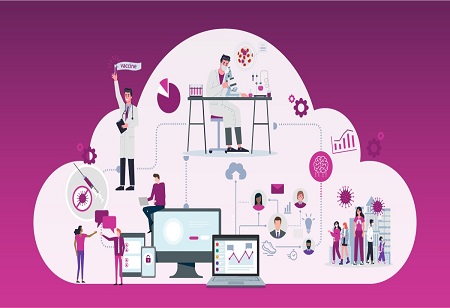Janifha Evangeline | Sunday, 02 October 2022

The new pharma health trends and the use of latest technologies such as Artificial Intelligence, Augmented Reality, additive manufacturing & Virtual Reality, are indications of a significant paradigm shift in the healthcare industry. These technologies enable pharma firms to not only augment the R&D process, develop personalized products & conduct testing in several innovative ways, but help in making healthcare highly effective as well as efficient, by changing the experience for patients & providers, ultimately.
The top 5 pharma tech trends that will transform the industry include: Artificial Intelligence Artificial Intelligence is evolving as highly pivotal in the healthcare industry. The Artificial Intelligence healthcare market size is predicted to reach a staggering USD 31.3 billion by 2025. Artificial Intelligence is already improving the healthcare industry with its significant predictive & data analytics capabilities. The implementation of Artificial Intelligence technology facilitates healthcare professionals for analyzing patterns in data sets in order to understand the implications, advantages as well as success rates of new drugs prior to launching them into the market. Artificial Intelligence is already improving the industry with its immense predictive and data analytics capabilities.
This use of AI technology enables healthcare professionals to analyze patterns in data sets to understand the implications, benefits and success rates of new drugs before launching them into the market. Pangaea Data, a British startup, leverages Artificial Intelligence alongside ML for real-world evidence studies & clinical trials. Panagea Data can scan electronic health records as well as illegible doctors’ notes to identify patients by levering Machine Learning-powered software. It is also building a library of Artificial Intelligence models for several disease areas. Another Canadian startup – Invivo novel Machine Learning strategies representation & few-shot learning for testing new drugs & selecting the best potential candidates for the medicine. These processes remove the need for large datasets, augmenting the drug discovery & development process.
Wearable tech integration Wearable tech integration helps pharma enterprises to do more than only manufacture, market & sell medicines. This technology renders patients, greater power in managing their conditions & making important decisions. There are a range of remote patient monitoring devices in the market that make it possible for doctors in tracking glucose as well as blood pressure metrics & keep tabs on chronic conditions such as asthma & diabetes. Daiichi-Sankyo - a Japanese drugmaker & Partners HealthCare
Center collaborated to implement the implementation of wearables. Both these institutions built a device coined “the mobile wrap-around”. This monitors patients who are diagnosed with atrial fibrillation & sends feedback to the doctors. Another early adopter of wearable tech integration is Roche – the company that paired the Accu-Chek Guide glucose meter with its mySugr app. This enabled diabetes patients to experience a different, as well as more responsive way in managing the condition.
Through this device, patients can log in as well as complete simple tasks that lets them to keep track of their glucose levels. While the approach is unique, practical, & effective, it renders patients a better experience rather than simply waiting around for answers.
Data Management & Analytics A biggest stumbling block in launching any newly discovered drug is the cost incurred in its R&D. For example, the development of either a new molecular compound or any biological medicine can cost somewhere around USD 2.6 billion, however, the ripple effect is that there is no adequate development as well as dispatching of effective medicines. pharma researchers can reduce exploration cycles, by leveraging big data and this will lead to the quicker discovery as well as distribution of new drugs. Furthermore, Big data can also facilitate in determining a drug’s side effects beforehand. This helps in reducing the time that is required for clinical trials.
The costs of R&D inflate the cost of medications, hence decreasing Research & Development cycles can help reduce the costs of medication for patients. Carnegie Mellon University is enhancing Research & Development by integrating big data with a ML algorithm which can test & analyze several drugs.
Single-Use processes As several pharma firms are embracing SUT or single-use technology in the manufacturing process, there are more & more industry players getting to know of the incredible benefits this technology offers. Single-use processes decrease the risk of product cross-contamination, and this makes it easy to maintain a sterilized manufacturing environment.
Precision medicine Precision medicine renders a new approach for disease diagnosis, treatment as well as prevention. This technology uses the lifestyle and genes of patients in order to help doctors take accurate, data-backed decisions. The precision medicine market value will exceed USD 96 billion by 2024 with a Compound Annual Growth Rate of 10.7 per cent and this growth is attributed to the success of recently targeted therapies. Precision medicine is set to revolutionize oncology, that would make possible personalized treatment for each patient, when implemented completely.
In a nutshell If there exists any silver lining from the pandemic, it was a huge wake-up call for pharmaceutical and healthcare industry and Pharma & healthcare enterprises are now rethinking their processes & how they can work more efficiently. Enterprises have to do their part in order to overcome the current business challenges. They should evaluate security for developing a robust cyber resilience framework & make sure they have the right team for leading a successful digital transformation.